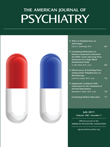Anti-NMDA Receptor Encephalitis Versus Pediatric Catatonia
To the Editor: The protracted course of catatonia in a 16-year-old boy was recently described in the March issue of the Journal as an example of anti-NMDA (N-methyl-d-aspartic acid) receptor encephalitis (1). The patient exhibited stupor, psychomotor retardation, mutism, posturing, stereotypical movements, refusal to eat and drink, and episodic agitation. These signs meet the criteria for catatonia, classified in DSM-IV-TR as catatonic disorder due to a general medical condition (293.89). No clear medical or toxic cause was found, nor were any of the prescribed psychotropic medications or immune therapies, including steroids, intravenous immune globulin, and rituximab, beneficial. After treatment with haloperidol and other antipsychotics, the symptoms worsened. The syndrome slowly abated, and the patient returned to baseline function 7 months after the onset of symptoms.
We question the diagnosis and management of anti-NMDA receptor encephalitis. The authors recognize catatonia and cite the effective use of ECT in similar presentations but do not explain why neither a focused trial of benzodiazepines nor ECT was applied. Benzodiazepine treatment is beneficial in catatonia, but the maximum prescribed dosage of lorazepam was 3 mg/day, with unspecified doses given on an as-needed basis. Such dosing schedules are inadequate for catatonia.
The enthusiasm for the newly defined disorder of anti-NMDA receptor encephalitis should not be a barrier for treating the recognized catatonia vigorously. The immune treatments that are recommended for the newly proposed form of synaptic autoimmune encephalitis often yield equivocal results in pediatric cases. This unsatisfactory experience contrasts with the swift improvement seen in adolescents with catatonia when ECT and up to 24 mg of lorazepam are promptly applied (2–4). The sharp increase in the number of reports of pediatric anti-NMDA receptor encephalitis strikes us as fashion driven, but it highlights the fact that catatonia is common yet often unacknowledged in children and adolescents (4, 5).
Pediatric patients who meet the criteria for anti-NMDA receptor encephalitis are better served with a diagnosis of catatonia, for which benzodiazepines and ECT are well-established first-line treatments that resolve symptoms quickly and safely. Studies comparing benzodiazepines or ECT with immune therapies in children, adolescents, and adults who meet criteria for catatonia and who test positive for the anti-NMDA receptor antibody are urgently needed (4, 6).
1. : Anti-NMDA receptor encephalitis: diagnosis, psychiatric presentation, and treatment. Am J Psychiatry 2011; 168:245–251Link, Google Scholar
2. : ECT for catatonia in an autistic girl. Am J Psychiatry 2008; 165:329–333Link, Google Scholar
3. : Electroconvulsive therapy for malignant catatonia in adolescence. South Med J 2009; 102:1170–1172Crossref, Medline, Google Scholar
4. : Catatonia: A Clinician's Guide to Diagnosis and Treatment. Cambridge, UK, Cambridge University Press, 2003Crossref, Google Scholar
5. : Catatonia is hidden in plain sight among different pediatric disorders: a review article. Pediatr Neurol 2010; 43:307–315Crossref, Medline, Google Scholar
6. : Pearls & oysters: electroconvulsive therapy in anti-NMDA receptor encephalitis. Neurology 2010; 75:e44–e46Crossref, Medline, Google Scholar



